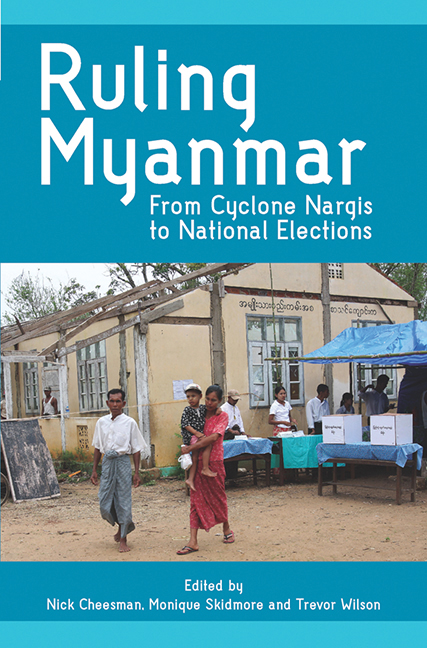Book contents
- Frontmatter
- Contents
- List of Tables
- List of Figures
- Background on ANU 2009 Myanmar/Burma Update Conference
- Acknowledgements
- Contributors and Editors
- Note on Terminology and Geographical Names
- Map of Myanmar
- Part I Overview
- Part II Political Legitimacy, Governance and Justice
- Part III Economic Development, the Rural Economy and Labour Rights
- 7 Myanmar's Response to the 2008 Global Financial Crisis
- 8 Recapitalizing Burma's Rural Credit System
- 9 Farmers, Land and Military Rule in Burma
- 10 The Movement of Rural Labour: A Case Study Based on Rakhine State
- Part IV The Role of International Cooperation and Governance
- List of Abbreviations
- Index
10 - The Movement of Rural Labour: A Case Study Based on Rakhine State
from Part III - Economic Development, the Rural Economy and Labour Rights
Published online by Cambridge University Press: 21 October 2015
- Frontmatter
- Contents
- List of Tables
- List of Figures
- Background on ANU 2009 Myanmar/Burma Update Conference
- Acknowledgements
- Contributors and Editors
- Note on Terminology and Geographical Names
- Map of Myanmar
- Part I Overview
- Part II Political Legitimacy, Governance and Justice
- Part III Economic Development, the Rural Economy and Labour Rights
- 7 Myanmar's Response to the 2008 Global Financial Crisis
- 8 Recapitalizing Burma's Rural Credit System
- 9 Farmers, Land and Military Rule in Burma
- 10 The Movement of Rural Labour: A Case Study Based on Rakhine State
- Part IV The Role of International Cooperation and Governance
- List of Abbreviations
- Index
Summary
INTRODUCTION
There is no significant rural–urban migration in Myanmar. This is mainly because full-scale industrialization was not implemented during the twenty-five years of the socialist regime or even after the twenty years of economic transition. The country's economic structure has barely changed over the past forty-five years and the capacity of the urban sector (industry as well as service) to absorb labour remains inadequate.
Nevertheless, limited rural–urban migration does not signify that rural Myanmar is static, with no population movement. We consider the following two population flows as being prominent since the start of economic transition in the late 1980s.
One is overseas emigration, which is rapidly increasing. The number of Myanmar migrants working on fishing boats, in factories, and at construction sites in Thailand has increased dramatically since around the mid-1990s (Bradford and Vicary 2005). Many Myanmar labourers are also working at ports and in factories in Malaysia. Even though the majority are fully aware of the severe working conditions in the destination countries, there is no end to the people who wish to migrate and are willing to pay exorbitant fees to migration brokers.
The other population flow is intra-rural migration. Previous research on domestic migration from an economic standpoint is limited, with the exception of a study by Takahashi (1997). Takahashi conducted a field survey in 1993–95 and found that 20 per cent of the village population had been replaced. His study found, first, that the major class of people migrating were non-farmers, especially agricultural labourers who did not own any farmland or other assets. As pointed out in many studies, there is a large pool of agricultural labourers in rural Myanmar (Takahashi 2000; Fujita 2009; Okamoto 2008a), and they constitute the floating population. Second, it found that there was not much change in their occupation after their move. For example, agricultural seasonal labourers tended to also engage in seasonal labour in their new place of employment. Furthermore, the destination area was mostly confined to within the same township in which they lived. In other words, the migrants’ reason for moving was not necessarily to gain a larger income under a completely different economic environment. In this sense, their move could not contribute much to increasing the total household income. What is more important here is stability of livelihood or the minimization of fluctuations in household income throughout the year.
- Type
- Chapter
- Information
- Ruling MyanmarFrom Cyclone Nargis to National Elections, pp. 168 - 194Publisher: ISEAS–Yusof Ishak InstitutePrint publication year: 2010



